The majestic constructions of the Ek Balam archaeological zone, hidden between enormous trees, captivate tourists worldwide.
This archaeological site is different from the rest of the Maya area and hundreds of walkers arrive daily to see the ruins that date back to approximately 300 BC.. They were active until the arrival of the Spanish.
The area was the capital of the Tah empire, to which the people of the eastern part of the State, including part of the coast, paid tribute. Offerings made of shells have been found at the site, according to guide Jaime Cahum.
The perimeter of this site covered about 12 square kilometers, including the central sacred space of just over a square kilometer, where the elite resided. This central area was protected and delimited by three walls, in addition, it had five entrances where the same number of roads led, known as sacbés or sak bé oob.
It was a capital with great wealth and had a population of 12 to 18 thousand inhabitants in the core area. It is said that it was founded by a man named Ek’ Balam or Coch Cal Balam, who arrived from the East and ruled for the first 40 years.

The city has 45 structures and is surrounded by two concentric stone walls and another one that unites the central buildings. These walls had defensive purposes and access control. It has a ball court and a very beautiful arch where a sacbé (sacred path) led, which in ancient times connected the Maya kingdoms. There are also steles and the so-called hieroglyphic serpents, monuments beautifully carved in stone blocks. The structures have various architectural styles, but some details make them unique, such as images with wings that resemble angels.
Numerous masks, friezes and stone statues have been found with allusions to the jaguar and great figures of the city, mainly effigies of its rulers, which shows us that it was a city that was outside the cult of Kukulkan.
The main site, the Acropolis, is a highly fortified elevation, measuring 160 meters long by almost 70 meters wide and 31 meters high. It is classified as one of the largest buildings in Yucatán and has numerous overlapping construction stages.
It has a large number of vaulted rooms, on different levels and connected by passages. Beneath the thatched roofs that protect the facade, we can appreciate the intricate detail of art and symbolism, incorporated in sculptures that adorn this temple and make the place an artistic marvel.
The discovery of a tomb with a rich offering inside, of the great ruler Ukit Kan Lek Tok, makes this structure the most important at the site. In this place, the only emblem glyph existing to date in the North of the State was found, in which the name of said ruler is mentioned.
Among his offerings were sea snail shells, pectorals, mother-of-pearl shells, jade objects, beads, some representations of faces, fragments of ear cuffs, and necklaces. Representations of fish and shrimp in shells, more than 25 vessels, and a deer femur with inscriptions were also located, which is assumed to have served as the center.

How to get to Ek Balam?
Ek Balam is located 26 km north of Valladolid and 186 km east of Mérida, on the highway to Cancún, and 30 kilometers from Tizimín. To get there, you pass through Temozón, then take a path where tourists pay 100 pesos to the Ejidatarios as a fee to enter the ruins.
As an additional attraction to the archaeological site, there is the X-Canché cenote, 1.5 kilometers away. It has a structure for practicing rappelling and zip lining, as well as a bicycle rental service, kayaks, cabins, dining rooms, and rest areas.
TYT Newsroom

